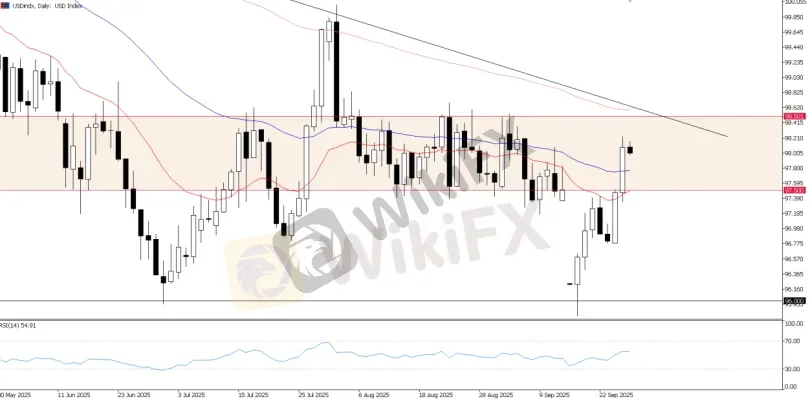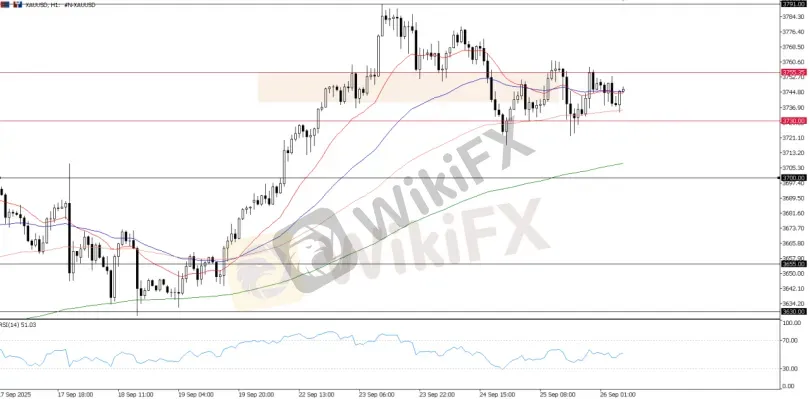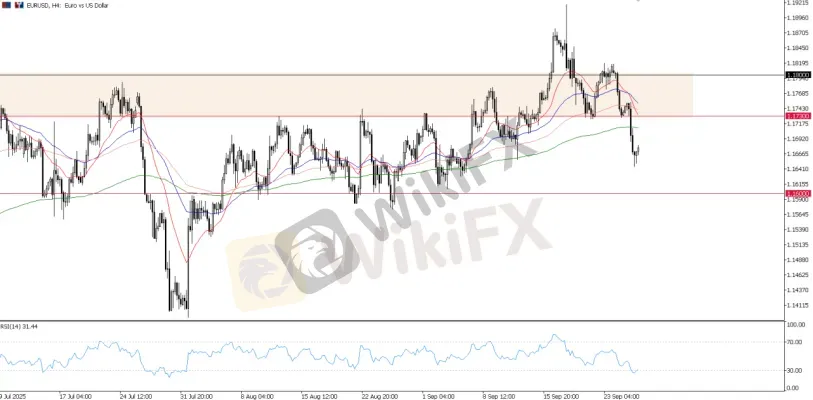DBG Markets: Market Report for Sep 26, 2025
Abstract:U.S. GDP Surprise Lifts Dollar, Market Eyes on PCE Price IndexThe U.S. dollar staged a sharp rebound on Wednesday after the second estimate of Q2 GDP showed growth accelerating to 3.8% annualized, bea
U.S. GDP Surprise Lifts Dollar, Market Eyes on PCE Price Index
The U.S. dollar staged a sharp rebound on Wednesday after the second estimate of Q2 GDP showed growth accelerating to 3.8% annualized, beating the prior 3.3% estimate and marking the strongest pace in nearly two years. The revision was driven by firmer consumer spending and business investment, suggesting the economy remains resilient despite headwinds from higher borrowing costs and tariffs.
This upside surprise helped push U.S. Treasury yields higher, particularly at the short end, while the U.S. Dollar Index (DXY) climbed out of its recent lows. The stronger growth data forced traders to reassess expectations of aggressive Fed easing, as the economy appears stronger than previously assumed.
Fed Outlook: PCE Data in Focus
The GDP release comes after Chair Jerome Powells recent cautious remarks, where he stressed that there is “no risk-free path” for policy. He warned that cutting rates too quickly could reignite inflation, but keeping rates elevated for too long may hurt the labor market.
Markets are now looking toward tonight‘s Personal Consumption Expenditures (PCE) Price Index — the Fed’s preferred inflation gauge — for confirmation on the disinflation trend. Consensus forecasts point to a 0.2% monthly increase in core PCE, keeping annual inflation steady near 2.8–2.9%.
· If PCE surprises to the upside, it could reinforce the case for the Fed to move cautiously, providing further support for the dollar.
· If PCE comes in soft, markets may revive expectations for a faster pace of rate cuts, likely weighing on the dollar and boosting gold.
The combination of GDP strength and the PCE outcome will set the tone for the Feds October and December meetings, where traders currently see at least one additional 25bps cut but remain divided on the likelihood of a second.
US Dollar: Retest Key Zones
The US Dollar Index hasa rebounded after the GDP surprise as market pushed back cut expectation. With the US Dollar index regain above the 97.50 – 98.50 zone after testing the 96.00 multi-years low support.
The bounce highlights strong buying interest at these levels, but the broader structure remains fragile.

USDindex, Daily Chart
Technically, the dollar continues to face a heavy cap at 97.50–98.50. A sustained break above this range would be needed to confirm a broader trend reversal. Conversely, failure to hold above this zone could expose the dollar to renewed downside risks.
For now, the dollars next decisive move will hinge on the PCE Price Index release. A stronger-than-expected print could lift DXY back toward the upper end of resistance, while a softer outcome may trigger another decline to retest the 96.00 support area.
Gold: Reversal or Continuation
Gold retreated from its record peak at $3,791–3,800, weighed down by the rebound in the U.S. dollar and profit-taking flows. However, the downside remains capped by recent support, keeping the broader trend intact.

XAU/USD, H1 Chart
In the near term, gold is consolidating within the $3,755–$3,730 range following the pullback. A break below the lower boundary of this range would increase the risk of a deeper correction, potentially dragging prices toward the $3,700 area.
Despite these short-term risks, golds overall trend remains bullish, supported by continued central bank demand and strong safe-haven flows. The key structural support sits at the $3,700–$3,631 zone.
On the upside, a breakout above the current consolidation range could reignite bullish momentum and drive the rally to fresh highs beyond $3,800.
EURUSD: Downside Risks Building

EURUSD, H4 Chart
EURUSD weakened following the rebound in the U.S. dollar. The pair failed to reclaim the 1.1800 key level, slipping back below the 1.1800–1.1730 zone, which now acts as a major resistance area.
As long as EURUSD holds under this zone, the risk of further downside increases. The next key target sits around 1.1600, though the move will ultimately depend on the dollars performance following upcoming U.S. data.
Bottom Line
The strong GDP print has given the dollar renewed strength, but tonights PCE inflation data will be the real test. If inflation proves sticky, markets may temper rate-cut expectations, reinforcing dollar support and weighing on gold in the short term. Conversely, a soft PCE could reignite dovish bets, keeping gold well bid.
WikiFX Broker
Latest News
He Clicked, He Transferred, and He Lost RM1.86 Million!
Behind the Licences: Is Pepperstone Really Safe for Malaysians?
Promised Recession... So Where Is It?
Treasury Secretary Bessent says U.S. GDP could take a hit from the government shutdown
Hirose Halts UK Retail Trading Amid Market Shift
Here is why cargo pilots are furious with the FedEx CEO
China’s Myanmar Scam Crackdown Intensifies with Death Sentences
CONSOB Blocks EurotradeCFD’s Solve Smart, 4X News
FINRA Fines United Capital Markets $25,000
PU Prime Halloween Lucky Draw 2025
Rate Calc


